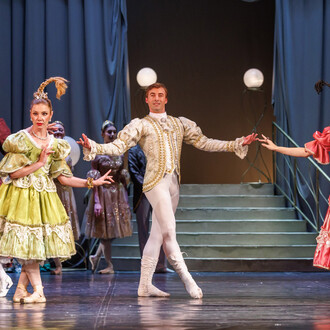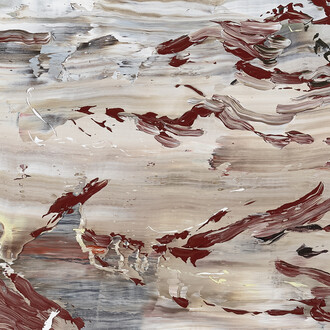Resonance is the thread that ties together the vision of the GAM's new management, weaving a common link around exhibitions, collections and projects and forming an organic whole. Each season is developed around specific themes that define its identity. First resonance explores the concepts of light, colour and time. Within this framework there are three exhibitions dedicated to major international artists: Berthe Morisot, whose Impressionist brushstrokes portray French society of the time, Maria Morganti, who through the layering of paint traces the memory of time, and Mary Heilmann, whose technique, influenced by the light of the West Coast and themes of the Beat Generation, reveals a simple complexity.
The GAM of Torino has renewed the display of its collections, enriched over time thanks also to the Fondazione Guido ed Ettore De Fornaris and the Fondazione per l’Arte Moderna e Contemporanea CRT, offering an exhibition itinerary that takes in the first and second floors of the building. The latter finally reopens to the public after renovation work.
The new layout, conceived in tune with the exhibitions of the autumn programme, is divided into fifteen rooms. To these is added a portion of the second floor transformed into a Living Depot, a display that emulates a museum depot and so allows visitors to enjoy an environment densely inhabited by the works and in continuous transformation. The architectural design of the Living Repository included the denuding of some walls to show the original sloping walls of the building conceived by Carlo Bassi and Goffredo Boschetti in 1959. Thus the original skeleton of the Gallery and its particular, brutalist architectural quality, which for years remained concealed, re-emerges. In the Living Repository, paintings, drawings and sculptures that, in more than one case, had not been shown to the public for some time, find their place on shelves, grid panels and sometimes in their packing cases.
Next, there is a room in which to rest, flooded with natural light as in the original 1959 project. It houses furniture, sculptures and paintings from the first half of the twentieth century. This space, imagined as a moment of ‘settling’, is the premise for an arrangement played out on the relationships, resonances and attractions between works and thematic nuclei of even very distant chronologies. Each room is a chapter in a story, with its own narrative and characters. Uniting the stories are motifs drawn from the poetics and practice of the three artists whose exhibitions will enliven the spaces of the GAM during the autumn period: Berthe Morisot and her airy, light-soaked painting; Mary Heilmann and her unorthodox approach to form and colour; Maria Morganti and her methodical, slow research into chromatic tones.
Room after room, the works are arranged to resonate alongside one another. One room, with works by Gastone Novelli, Achille Perilli, Alberto Burri, Cy Twombly and Franco Vaccari, is dedicated to those sign experiments of the 1950s in which walls were transformed into palimpsests of lived life.
In the next room, city walls give way to the man-made landscape of the countryside. Pedro Cabrita Reis’ monumental Semina is placed in dialogue with a photographic selection of melancholic ploughed fields by Mario Giacomelli. While the mythology of journey constitutes the main theme of the following room in which works by Massimo d’Azeglio, Otto Dix, Osvaldo Licini and Luigi Ontani are compared.
Chromatic, atmospheric and seasonal transitions bring together works by Luciano Fabro, Mario Reviglione, Medardo Rosso, Leoncillo and Leonardo Bistolfi. The latter are displayed in the passage between the two wings of the second floor, where natural light, for years screened by plasterboard walls, is now free to enter. In the next two rooms, which are more intimate and cosy, some new acquisitions are confronted with better-known works from the museum collections. Bill Lynch’s spontaneous brushstrokes are reflected in Filippo De Pisis’ still lifes; Michele Tocca’s pictorial vapours in Luigi Ghirri’s photographs and Antonio Fontanesi’s paintings.
The second floor concludes with a lively and boisterous chromatic vibration, with Nicola De Maria’s large canvas Regno dei fiori musicali. Universo senza bombe appears alongside works by Carla Accardi, Lucio Fontana and Giuseppe Capogrossi.
The resonances continue on the lower floor, where the presence of a contemporary artist, with his or her particular sensitivity, allows known works to be reinterpreted, creating unexpected visual assonances or contrasts. Lorenza Boisi and Stefano Arienti establish a dialogue with Lorenzo Delleani, Enrico Reycend and Mario Gabinio; Maria Morganti with the Venetian painting of Giacomo Favretto, Guglielmo Ciardi and Tancredi Parmeggiani. Pesce Khete’s chromatic violence confronts the cursive sign of Karel Appel and the expressive vigour of Pinot Gallizio. While Luca Bertolo shares his space with Andy Warhol, Franco Angeli, Pino Pascali and Mario Schifano.
There is no shortage of environments arising from thematic comparisons: the chromatic rhythmicity of Piero Dorazio is compared with the atmospheric one of Antonio Fontanesi; the musicality of Giuseppe Pellizza da Volpedo and Vittore Grubicy De Dragon with the geometry and seriality of Giacomo Balla, Sergio Lombardo and Robin Rhode. Finally, Francesco Jodice’s glittering city and Franco Fontana’s glossy city come alive in the presence of works by Salvatore Scarpitta, Giosetta Fioroni, Michelangelo Pistoletto, Titina Maselli, Jessica Stockholder and Jannis Kounellis.
















